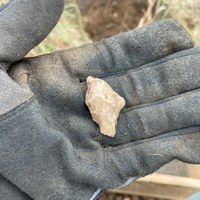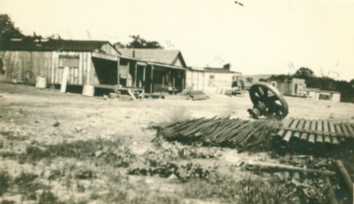History
Footprints of the Past
Remnants of Indigenous people
 For over 8,000 years, Indigenous people lived on this land and passed down the skills needed to survive to the next generation. These skills included techniques for using what the land offered to make food, clothing, medicine and shelter.
For over 8,000 years, Indigenous people lived on this land and passed down the skills needed to survive to the next generation. These skills included techniques for using what the land offered to make food, clothing, medicine and shelter.
Even the rocks were a valuable resource! Using a technique called knapping, these Indigenous people created tools by striking a hammerstone against another type of stone, usually chert, to chip off small flakes until the desired shape was formed.
Remember: Don’t pocket the past. Removing artifacts prevents others from experiencing this fascinating history and is illegal.
Impact of early Europeans
Before the arrival of Europeans, many Native American tribes called this area home, including the Tonkawa, Kiowa, Comanche, Lipan Apache and Wichita.
Spanish explorers arrived in the 1630s and brought horses with them. Lipan Apache were among the first tribes of Central Texas to incorporate horses into their culture, but the Comanche’s horsemanship later became legendary.
As westward expansion continued, conflict between pioneers and tribes grew. Pioneers sought new opportunities, while tribes defended their way of life.
In the early 1700s, the Comanche formed an impressive military force to protect their home, which spanned the Southern Plains and beyond. They eventually fell to the U.S. military in the 1870s, and the number of European settlements grew exponentially.
Into industrialization
 After the Civil War ended in 1865, ranching became a way of life and a main source of income in this area. To sell their cattle, ranchers and cowboys had to transport the cattle from catch pens to market, which was not always an easy task.
After the Civil War ended in 1865, ranching became a way of life and a main source of income in this area. To sell their cattle, ranchers and cowboys had to transport the cattle from catch pens to market, which was not always an easy task.
In 1880, the Texas and Pacific Railroad built tracks through the small town of Strawn. This made transporting cattle to market easier, brought new commerce, and put Strawn on the map.
Building the railroad also required the construction of a few supporting structures, including several low-water dams along Palo Pinto Creek and a brick bread oven. The dams provided water for steam engines, and the oven baked many loaves to feed railroad crews.
These smaller structures and our historic catch pens are no longer in use, but the railroad is still active and moving goods along the park’s northern border.
Pro tip: Ask a ranger for the best places to observe the train safely. Wandering onto or under the train tracks and trestles is dangerous and considered trespassing.
Haunted hills
 Thanks to the new railroad and a growing demand for fossil fuels, many entrepreneurs eagerly searched for oil.
Thanks to the new railroad and a growing demand for fossil fuels, many entrepreneurs eagerly searched for oil.
In 1915, liquid gold spewed from the ground of what would one day become Palo Pinto Mountains State Park. The resulting economic boom led many oil and railroad workers to settle near the tracks, creating the town of Wiles. Residents built homes, opened stores and markets, started families and created an oilfield community.
As time went on, fossil fuel production decreased and safety measures for the railroad improved. This led to fewer jobs, and people eventually moved away in search of work. The town of Wiles was completely deserted by 1959. The last structures of this ghost town still stand, as nature slowly reclaims the landscape.
A lakeside legacy
During the Great Depression, President Franklin D. Roosevelt established the Works Progress Administration (WPA). This organization created jobs by building infrastructure, public buildings and recreational facilities. The WPA impounded Russell Creek to create Tucker Lake in 1937. About 35 feet at its deepest point, the 90-acre lake provided drinking water and recreation for the city of Strawn.
Vacation cottages once stood along the western bank, offering families and friends a place to swim, kayak, boat and camp. You can see remains of those cottages just past our fishing pier. While the cottages are gone, Tucker Lake continues to serve as both a recreational site and a water source for Strawn.
Note: Tucker Lake is a no-gas, no-wake lake. Help protect this natural resource by using only non-gas and non-diesel watercrafts.
The Newest State Park in Texas
In 2010, the Texas Parks and Wildlife Department partnered with The Nature Conservancy to seek land for a new state park in North Texas. This partnership, combined with proceeds from the agency’s sale of property on Eagle Mountain Lake, led to the purchase of the initial 3,300 acres of Palo Pinto Mountains State Park in 2011. But that was just the start!
In 2014, the City of Strawn leased Tucker Lake to Texas State Parks. This, along with more land acquisitions, has now expanded the park to 4,871 acres. When the park opens, it will be the first new Texas State Park in 25 years.
Keep an eye on social media and TPWD’s website for an opening date.
